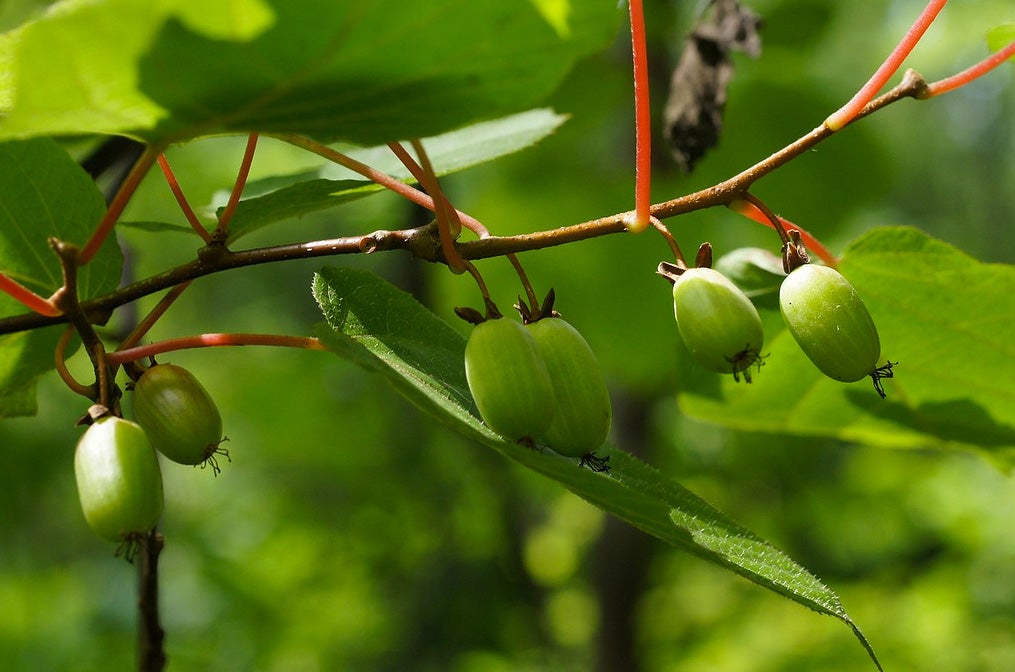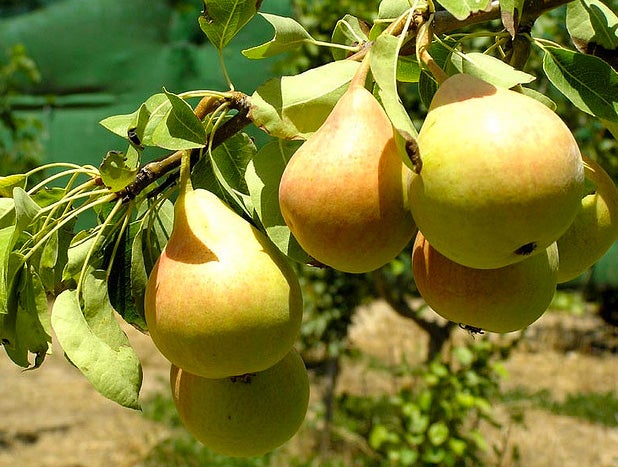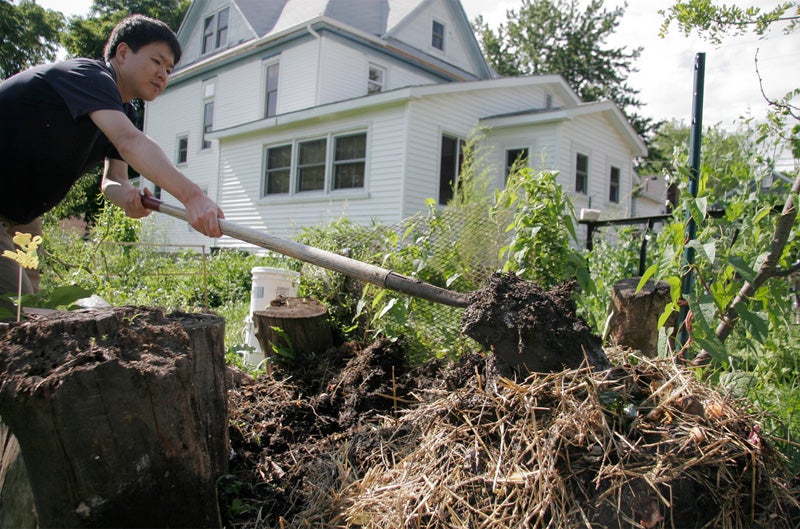Are roots invading your compost pile?
ListenMike explains how to grow a Bermuda grass lawn, the best way to care for a transplanted lilac tree, how to move a tree from its pot to the ground, the dangers of soil compaction, why goats work best for weeds and what to do about roots in your compost pile.
Question of the Week:
“I have a compost bin made out of four wooden skids. I placed two layers of cardboard in the bottom last fall and filled it with leaves that I shredded three times with a bagging mower. But when I went to empty the compost onto the garden this fall, I had Forsythia roots coming up into the bottom of the pile that made things really difficult. What can be done to prevent this? It would be difficult to change the location, as it has to be placed out of the wife’s sight as much as possible.”
— Bob in Portsmouth, New Hampshire
What to do about vines and roots growing in your compost pile »
Highlights from show for November 23, 2013:
Growing Bermuda grass
Mike from Goldsboro, North Carolina is looking to improve his lawn. His neighbor has a Bermuda grass lawn, and because their lawns are adjacent, Mike would like to install Bermuda grass on his side as well so the two lawns match. Mike McGrath responded with a laugh, saying: “You know, if you do nothing, man, his Bermuda grass will eventually take over your lawn in a couple of years.” Mike McGrath then explained that the first task is to identify exactly what variety of Bermuda grass his neighbor has by asking him what the “brand name” is of the variety he planted and where he got it. The next task is to till up the existing lawn, get a load of topsoil to make a good seed bed and install the grass as the weather warms up. The installation and care for the lawn should match his neighbor’s treatment to get the closest match.
Caring for a transplanted lilac tree
Jit from Paoli, Pennsylvania is having trouble with her lilac tree. She transplanted to her new house from her old property and is disappointed that the tree has not bloomed. It used to bloom reliably, but since the move it has gone dormant. She explained to Mike that it receives plenty of afternoon sun, she’s fed it with MiracleGrow and she pruned it in the fall. Mike offered a few notes for Jit, starting with the level of sun the lilac is receiving: “You know, these are drama queens. This is one of the top three drama queens in the garden and they really like morning sun.” Mike first recommends moving the plant somewhere where it will get full, morning sun. His second recommendation is to quit feeding it — especially with a chemical like MiracleGrow. And lastly, he explains that the best time to prune a spring-blooming plant like lilac, rododendron, or azaela is in the springtime right after it blooms. If she prunes the plant in the fall, she will not see blooms in the spring.
“You know, [lilacs] are drama queens. This is one of the top three drama queens in the garden and they really like morning sun.”
Mike McGrath
-

Photo by Flickr user Rico San
Use goats to clear your weeds
Joe just purchased 10 acres in upstate Michigan and would like to convert 2 or 3 of those acres into pastures for a hobby farm. The problem is that those acres are heavily weeded and he’s not sure how to clear them. When Joe was explaining the type of animals he’d like to get for his farm, Mike stopped him at goats and said: “Get the goats right away, baby, and turn them loose in the pasture! The goats will eat your weeds. That is the easiest, the most ecologically sound and the most productive way to get rid of the weeds.”
-

Photo by Flickr user ILRI
Moving a potted tree into the ground
Joanna in Mercerville, NJ got a lovely fig tree as an anniversary gift from her husband. The tree, which is potted, seems to be losing it’s leaves. Joanna wants to know what to do now. Mike thinks the best thing to do is to get it into the ground since this is the perfect time to do that. So he suggests taking the tree out of the pot and planting it in a hole that is protected from wind. He also suggests taking stakes and burlap to cover the plant during Winter. Once Spring arrives Joanna can remove the burlap and prune off any damaged branches. After that the tree should just grow! And … Mike reassures her, “It would not be impossible for you to get figs to eat at the end of next summer.”
Protect the roots of your trees
David from Greenville, SC is planning on moving his driveway right between two large oak trees. Mike’s first question is “why?” David needs to create a new driveway because the current driveway is shared with a neighbor. He intends to turn the old driveway into a garden and create a new one. Mike still seems skeptical about this choice and warns that plant death often occurs from soil compaction. So he recommends core aerating the area before he lays any gravel down for the driveway. After that it’s best to do nothing for the trees. “Don’t feed your trees or mulch your trees or give them any kind of injections.”
Growing hardy kiwi
Larry from New Tripoli, Pennsylvania planted two kiwi plants in the spring of 2012 and they have have been thriving but have not produced fruits or flowers. Based on the timeline and size of the plants Larry describes, Mike says not to worry. Mike explains: “These plants typically need some time to get established, and then after they get established, they’ll produce a lot of little fruits that’ll feed the birds and the squirrels — instead of you!” Mike continues on to explain that these plants have reached the maturity point where it’s necessary to prune them to encourage fruit and flower development and he advises Larry to check out Pennsylvania’s extension service for regional information about caring for hardy kiwis.
-

Hardy kiwi plant. Photo by Flickr user Tatiana Gerus
Getting the best out of your fruit trees
Richard from Bristol, Tennessee has a new home with a variety of pear trees in his yard. The trees haven’t been pruned in years, and a couple have sustained some damage. He’d like to remove the damaged trees, but he’s concerned that taking them out of the mix will affect the yield and of the remaining fruit trees. Mike agrees, explaining: “The more trees you have, the more fruits you get from each tree and the better the quality of the fruit.” To make the best decision about which trees to remove, Mike advises Richard to thin out some of the overgrowth in the trees this winter while the trees are dormant. In the spring, Mike explains that if Richard still wants to remove some trees, he should wait until the spring and remove the ones that do not pollinate on the sames schedule as the others. Mike says: “Mark the dates that they pollinate, that the flowers open and that the last flowers drop off. The trees you want to keep are the ones that are in the best cluster for their flowers being open at the same time. That’s where pollination counts — when your flowers are open and your native bees are going back and forth from tree to tree.”
-

Photo by Flickr user qvark
“The more trees you have, the more fruits you get from each tree and the better the quality of the fruit.”
Mike McGrath
WHYY is your source for fact-based, in-depth journalism and information. As a nonprofit organization, we rely on financial support from readers like you. Please give today.





